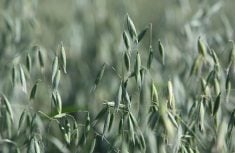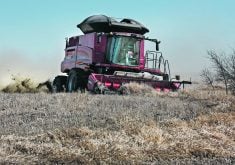Getting canola in the ground in the first week to 10 days of May generally improves yield by between five and 12 percent over later seeded crops, says the Canola Council of Canada.
Research trials conducted by the council show that 70 percent of the time, canola yields are highest when planted by the end of the first week in May, despite being seeded into soil that often is only marginally fit for canola seedlings.
Council agronomist David Blais said soil temperatures above 5 C will support canola germination, albeit more slowly than an ideal 10 C soil.
Read Also

VIDEO: Green Lightning and Nytro Ag win sustainability innovation award
Nytro Ag Corp and Green Lightning recieved an innovation award at Ag in Motion 2025 for the Green Lightning Nitrogen Machine, which converts atmospheric nitrogen into a plant-usable form.
The earlier dates also help reduce the threat of fall frost. If the crop is seeded 12 days earlier than an average mid-May planting, it harvests eight days sooner. An earlier seeded crop harvests 19 days sooner than one planted at the end of May.
Jim Bessel of the canola council said canola can be competitive with early season weeds when planted earlier, potentially eliminating a second in-crop herbicide application or the loss of moisture and nutrients to weed populations and warm, windy weather.
Early seeded plant leaves obtain their largest surface area at the same time that daylight hours are longest, increasing plants’ metabolic rates.
Blais said blossom blast is also reduced because plants enter flower stages a week earlier, providing more days of blooming before the heat of mid July.
Clint Rousell, who trains producers and dealers in the proper setup and use of drills for CNH’s Flexi-Coil division, said seeding canola into the top 2.5 centimetres of soil is critical to canola production.
“We tend to plant into moisture, and in some cases that is necessary. There is no better moisture than in the top few inches in early May.”
Rousell said a properly set drill delivers seed reliably in the 1.5 to 2.5 centimetre depth.
“It should be balanced in the field, not in the yard: front to back and side-to-side. And in the wheel tracks, shanks need to shimmed or set lower to accommodate the depressed soil.”
Blais said speed kills yields when it comes to canola. Higher field speeds may seem necessary with thousands of acres to cover and only a few weeks to get over them, but the agronomist said recent research shows poor seed and fertilizer location reduces plant stands dramatically.
Bayer Crop Science performed the seeding speed trial and said yields can be reduced by nearly 50 percent between four and seven mph.
Bayer’s research showed that crops seeded at four mph achieved 82 plants per sq. metre after 21 days. At a common seeding speed of five mph, that number dropped to 75. At seven mph only 47 plants per sq. metre appeared out of the ground.
Blais said a jump from five to 5.5 mph, with a standard plant emergence rate of 50 percent, would force producers to add an additional 1.5 pounds of seed per acre to obtain the same plant stand.
“If that seed cost you $4 a pound then you added $6 an acre to your costs,” he said.
Optimum plant stands for maximum yields range from a low of seven to a high of 14 plants per sq. foot.
Bessel said seed size can also affect plant viability.
“But producers need to remember that larger seeds still only can produce one plant per seed. So you need more pounds of seed to obtain a target stand as your TSW rises,” he said.
Seed size is based on a weight, in grams, per 1,000 seeds, also known as the TSW.
Under average conditions, a 3.5 TSW seed lot will require a five lb. per acre seeding rate to achieve a target plant stand of about 7.5 plants per sq. foot, while a five TSW will need seven lb. to generate the same number of plants.
Seed chlorophyll can reduce vigour and increase seed mortality, so levels should be tested and kept below 35 milligrams per kilogram.
In canola plant canopy manipulation studies, fields with populations of more than six plants per sq. foot returned an average of $33 per acre more than fields with three plants per sq. foot.
Blais said research has shown lower plant density crops take longer to mature.
“That can mean a lot to a farmer on Aug. 25,” he said.
Rousell said producers need to consider their contributions to insect populations and early frost when deciding on seeding rates and dates.
“Most air drills will tend to over seed a little bit, and you might not want to correct too much for that if you’re planting early or if you need to give a few leaves to the flea beetles.”
















